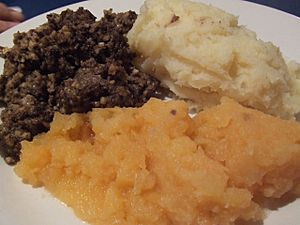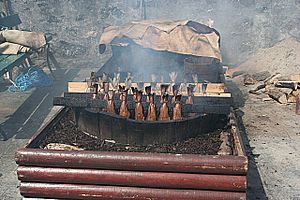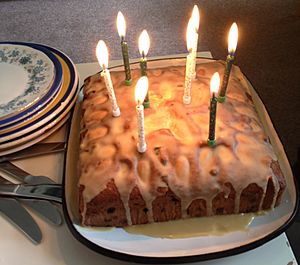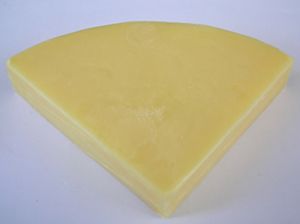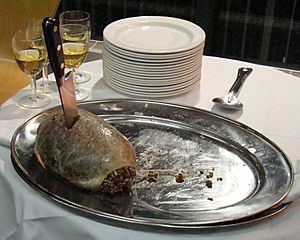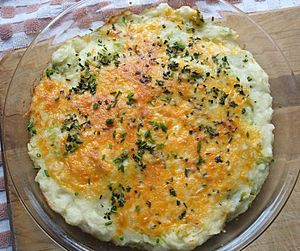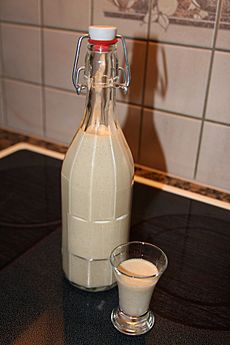Scottish cuisine facts for kids
Scottish cuisine is all about the special cooking styles, traditions, and recipes from Scotland. It has its own unique dishes, but it also shares many things with British and wider European cuisine. This is because of influences from different places and times, both old and new.
Scotland has amazing natural ingredients. These include vegetables, fruits, oats, fish and other seafood, dairy products, and game. These ingredients are the main reason for traditional Scottish cooking. It often focuses on simple dishes with not too many spices, as expensive spices from other countries were rare long ago.
Contents
A Look Back at Scottish Food History
Scotland has a mild climate and lots of wild animals. This has given its people plenty of food for thousands of years. The many types of seafood found near the coasts helped the first people survive. Later, farming began, and simple oats quickly became a main food.
In the past, meat was very expensive for most people. Even for those who worked on farms, meat was eaten only sometimes. Instead, people relied on products from their animals, like milk and cheese.
You can still see this in traditional Scottish food today, with its focus on dairy. A typical meal might have been a thick soup (called pottage) made from herbs and roots. If they had it, some meat (often seafood) or broth would be added for flavor. Bread, eggs, cheese, or seaweed were also eaten when possible. In some coastal areas, pigs were thought to bring bad luck. So, people there didn't keep or eat pigs until the early 1900s.
Like many places in Europe long ago, Scotland was a feudal state. This meant there were rules about what people could hunt and eat. In the homes of rich lords, you might find venison (deer meat), boar, different birds, and expensive spices like pepper, cloves, and cinnamon. They also ate meats from farm animals.
Before Sir Walter Raleigh brought the potato to Britain, Scots mainly ate bread made from oats or barley. Wheat was hard to grow because of the damp weather. People were very careful not to waste food. Old rubbish piles show that almost every part of an animal was used.
People in Scotland used to move around a lot. Because of this, they needed food that wouldn't spoil quickly. It was common to carry a small bag of oatmeal. This could be easily turned into a simple porridge or oatcakes using a girdle (a flat cooking pan). Scotland's national dish, haggis, might have started in a similar way. It's made from a small amount of offal (animal organs) or less popular meat. This was carried in a cheap bag, like a sheep's or pig's stomach. Some also think that Norse invaders brought this dish. They needed a way to keep food fresh during their long trips from Scandinavia.
French Cooking Influences
During the Late Middle Ages and early modern era, French cooking became important in Scotland. This happened because of the "Auld Alliance" (a long friendship between Scotland and France). It was especially true when Mary, Queen of Scots ruled. When Mary came back to Scotland, she brought French cooks with her. They are believed to have greatly changed Scottish cooking and even added some unique French words to Scottish food terms.
French Words Used in Scottish Cooking
- Ashet – from assiette (French for plate), meaning a large serving platter.
- Cannel – from cannelle, meaning cinnamon.
- Collop – from escalope, meaning a thin slice of meat.
- Gigot – from gigot, meaning a leg of mutton (sheep meat).
- Howtowdie – from hétoudeau (Old French), meaning a chicken for boiling.
- Syboe – from ciboule, meaning a spring onion.
As large country estates grew and land was fenced off in the 1700s, harvesting Scotland's natural food became a big business. Railways helped food reach more places. For example, Scottish grouse (a type of bird) became very popular in English restaurants soon after the "Glorious Twelfth" (the start of the grouse hunting season).
Food in the 1900s and 2000s
Like other parts of the United Kingdom, Scotland had less variety of food in the 1900s. Food rationing during the two World Wars and large-scale farming limited what people could buy. However, foods from the British Empire and other countries did bring new tastes to Scotland.
In the 1800s and 1900s, many people moved to Scotland from Italy. Later, more people came from the Middle East, India, and Pakistan. These cultures have had a huge impact on Scottish cooking. Italians brought back the idea of fresh ingredients. People from other countries introduced new spices. Since the European Union grew in the early 2000s, more people from Eastern Europe, especially Poland, have moved to Scotland. Many special restaurants and food shops for these new immigrants have opened in bigger towns and cities.
Traditional Scottish Dishes and Foods
These are some of the traditional dishes and foods from Scotland.
Cereal Dishes
Soups
Fish and Seafood
Meat, Poultry, and Game
Vegetables
Fruits
|
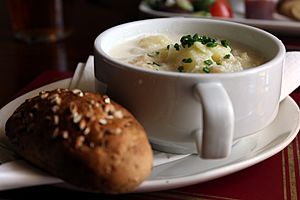
Cullen skink (right), served with bread
Dairy Products
Puddings and Desserts
Cakes, Breads, and Sweets
Preserves and Spreads
|
Scottish Drinks
Alcoholic Drinks (for adults)
- 90 shilling ale, 80 shilling ale, 70 shilling ale – types of Scottish beer.
- India pale ale – a type of strong, hoppy beer.
- Atholl Brose – a drink made with oatmeal brose, honey, whisky, and sometimes cream.
- Drambuie – a sweet, golden Scottish liqueur.
- Ginger wine – a wine flavored with ginger.
- Het pint – hot spiced ale that can have sugar, eggs, and spirits added.
- Heather ale – ale flavored with young heather tops.
- Scotch ale and beer – types of Scottish beer.
- Scotch mist – a cocktail mainly containing whisky.
- Whisky – Scotland's famous spirit.
Non-Alcoholic Drinks
- Breakfast tea – a common type of tea.
- Irn-Bru – a bright orange carbonated soft drink, very popular in Scotland.
- Red Kola – a bright red carbonated soft drink.
- Sugarelly – a type of licorice candy that can be dissolved in water to make a drink.
Restaurants and Fast Food in Scotland
Recently, Haggis pakoras (haggis in a crispy batter) have become popular in Indian restaurants.
Fast Food Choices
Scotland has seen a rise in fast food since the late 1900s. Fish and chip shops are still very popular. A battered and fried haggis supper is a favorite meal. In the area around Edinburgh, people often put "salt and sauce" on their chip shop meals. This sauce is brown sauce mixed with water and vinegar. However, in Glasgow and other places, this "chippy sauce" is not known. People there prefer ketchup or just salt and vinegar. This often leads to friendly debates between people from different cities!
Places selling pizzas, kebabs, pakoras, and other quick foods have also become very popular. An extreme example of this is the Munchy box, which is a large box filled with different fast foods.
Besides local fast-food places, American-style burger bars like Wimpy came to Scotland in the 1960s. In the 1980s, McDonald's, Burger King, Pizza Hut, and Kentucky Fried Chicken opened. Later, many Subway sandwich shops appeared in the early 2000s. You can also find many Greggs bakeries on Scottish high streets, selling cakes, pastries, and sandwiches, often alongside smaller local bakeries.
Famous Scottish Chefs
- Andrew Fairlie
- Tom Kitchin
- Tom Lewis
- Angela Malik
- Alan Murchison
- Nick Nairn
- Gordon Ramsay
- Mark Greenaway
- Tony Singh
- William Curley
- James Morton
See also
 In Spanish: Gastronomía de Escocia para niños
In Spanish: Gastronomía de Escocia para niños


